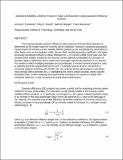Extracting Mobility-Lifetime Product in Solar Cell Absorbers Using Quantum Efficiency Analysis
Author(s)
Poindexter, Jeremy Roger; Brandt, Riley E; Mangan, Niall Mari; Buonassisi, Anthony
DownloadPoindexterSpring2015MRSConferenceProceedingrevised.pdf (596.7Kb)
OPEN_ACCESS_POLICY
Open Access Policy
Creative Commons Attribution-Noncommercial-Share Alike
Terms of use
Metadata
Show full item recordAbstract
© 2015 Material Reserch Society. The long-wavelength quantum efficiency (QE) response of photovoltaic absorbers is determined by the length scales for minority carrier collection. However, extracting quantitative measurements of minority carrier mobility-lifetime product (jut) is complicated by uncertainty in other factors such as the depletion width, electric field, and the absorption coefficient. We apply previously developed methods to obtain estimates for ja in a tin(Il) sulfide (SnS) solar cell. We compare three analytic models for the minority carrier collection probability as a function of absorber depth to determine which model most accurately captures the behavior in our devices. For models in which multiple parameters are unconstrained, a random numerical search is used to optimize the fit to experimental QE for SnS. To identify sources of error, we perform a sensitivity analysis by fitting with SCAPS-1D. Our analysis shows that changes in absorption most strongly affect estimates for /.a, highlighting the need to obtain accurate, device-specific absorption data. Further modeling and experimental constraints are required to obtain self- consistent values for jit that correspond to actual device performance.
Date issued
2015-05Department
Massachusetts Institute of Technology. Department of Materials Science and Engineering; Massachusetts Institute of Technology. Department of Mechanical EngineeringJournal
MRS Proceedings
Publisher
Cambridge University Press
Citation
Poindexter, Jeremy R. et al. “Extracting Mobility-Lifetime Product in Solar Cell Absorbers Using Quantum Efficiency Analysis.” MRS Proceedings 1771 (2015): 139–144 © 2015 Materials Research Society
Version: Author's final manuscript
ISSN
1946-4274